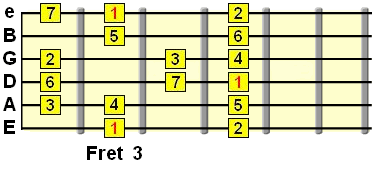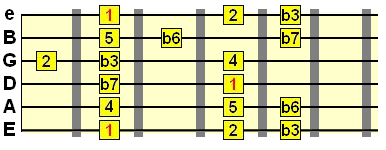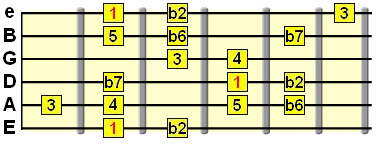Home
> Scales
> Major
& Minor
When learning guitar scales, there are two main types of scale you'll come across - major scales and minor scales.
Just like major and minor chords, both have unique applications when it comes to harmony. You'll be exploring these harmonic differences in more depth in the individual scale lessons, but let's first clear up some key differences.
This is known as the major triad, the basis of major scales (and chords).
The root marks the 1st note of our scale, and tells us the key in which the scale is being played. Whichever note the root lies is the theoretical key of the scale. This is why it's important to know the notes on the fretboard.
The 3rd is also known as the major 3rd. This is the tone that makes our scale a major scale.
The 5th is considered a neutral tone, because it's part of both major and minor triads (triad = three tones). In some scales, however, the 5th will be flat or even sharp (b5 and #5 respectively), so look out for that, as it tells you what type of chord it will work over.
So how will you know if the scale contains these tones? Well, if you're using this site to learn scales, the tones are clearly marked. For example, what does the scale diagram below tell us?...

There is a root (1), 3rd (3) and 5th (5) present in that scale, so we know it's a major scale. There is also an indication that this particular example is being used at the 3rd fret (the position of its lowest root note).
Therefore, the scale is in the key of G major, because the lowest root note G lies at the 3rd fret on the low E string.
Another question you might have is "why do I need to know if it's a major scale?"
A major scale can only be played over major chords and certain major key progressions. See, just like scales, if the chord you're playing the scale over (in a solo for example) contains the root and 3rd, it will be compatible because both the scale and chord will be major.
This is the intrinsic relationship between scale tones and chord tones you'll come to appreciate. Once fully mastered, you'll be able to apply scales over the entire fretboard for fluid and effortless soloing.
So, in this example, our G major scale will work over a G major chord. It may also work over certain G major key progressions. More on that another time!
This is known as the minor triad, the basis of minor scales (and chords).
The minor 3rd (also known as a flat 3rd or b3 for short) is the tone which makes a scale or chord minor.
The 3rd is "flat" or "minor", because it can be seen as lowered by a semitone/half step (the equivalent of one fret) from its natural major scale position. Flats and sharps are always referenced against the major scale, even in minor scales.
Here is just one type of minor scale, known as natural minor...

So you can see there is a minor 3rd present in that scale. The other flat tones - b6 and b7 - are also referenced against their natural major scale positions, but these tones don't determine if the scale is major/minor. Only the 3rd does that!
Get to know this relationship between the root of a scale and its 3rd, whether major or minor 3rd. The sound of this interval should be engrained in your mind, no matter which key you play it in.
It's one of those things where you only truly realise how important this knowledge is the more you progress.
In the scales section, there are several major and minor scales to learn (I'm adding new lessons all the time), so when it comes to playing over major and minor chords, you'll have a good selection of scales to choose from.
Each scale is different, and the more you play around with different scales, the more your ear will pick up on these surrounding tones. These tones are what give the scale its unique flavour, beyond simply major/minor.
For example, here's the Phrygian Dominant scale...

Notice the major triad present there, so we know it's a major scale and will work over major chords. However, there is also a minor/flat 2nd (b2) which gives it a very distinctive sound. We'll look more in depth at these scales in their individual lessons.
So, a lot to think about, but it's useful to be introduced to this stuff early on, so you're prepared for learning scales.
Don't just learn them as patterns on the fretboard - understand their ingredients! It's only by doing this that you will truly understand how scales and chords work together as part of the same foundation of intervals.
Major & Minor Guitar Scales
This is an important preliminary lesson for anyone wanting to understand the distinction between major and minor guitar scales and how they work over any chords that are being played in the background. Free scale
pattern cheat sheet Free scale
pattern cheat sheetEssential scale patterns that every guitarist must know... Click here to start now |
When learning guitar scales, there are two main types of scale you'll come across - major scales and minor scales.
Just like major and minor chords, both have unique applications when it comes to harmony. You'll be exploring these harmonic differences in more depth in the individual scale lessons, but let's first clear up some key differences.
Major scale basics
There are certain tones that a scale must contain to make it a major scale. These are exactly the same tones that a chord must contain to make it a major chord...| Root | Major 3rd | 5th |
| 1 | 3 | 5 |
This is known as the major triad, the basis of major scales (and chords).
The root marks the 1st note of our scale, and tells us the key in which the scale is being played. Whichever note the root lies is the theoretical key of the scale. This is why it's important to know the notes on the fretboard.
The 3rd is also known as the major 3rd. This is the tone that makes our scale a major scale.
The 5th is considered a neutral tone, because it's part of both major and minor triads (triad = three tones). In some scales, however, the 5th will be flat or even sharp (b5 and #5 respectively), so look out for that, as it tells you what type of chord it will work over.
So how will you know if the scale contains these tones? Well, if you're using this site to learn scales, the tones are clearly marked. For example, what does the scale diagram below tell us?...

There is a root (1), 3rd (3) and 5th (5) present in that scale, so we know it's a major scale. There is also an indication that this particular example is being used at the 3rd fret (the position of its lowest root note).
Therefore, the scale is in the key of G major, because the lowest root note G lies at the 3rd fret on the low E string.
Another question you might have is "why do I need to know if it's a major scale?"
A major scale can only be played over major chords and certain major key progressions. See, just like scales, if the chord you're playing the scale over (in a solo for example) contains the root and 3rd, it will be compatible because both the scale and chord will be major.
This is the intrinsic relationship between scale tones and chord tones you'll come to appreciate. Once fully mastered, you'll be able to apply scales over the entire fretboard for fluid and effortless soloing.
So, in this example, our G major scale will work over a G major chord. It may also work over certain G major key progressions. More on that another time!
Minor scale basics
Just like with major scales, there are tones present in minor scales that tell us they're compatible with minor chords and certain minor key progressions.| Root | Minor 3rd | 5th |
| 1 | b3 | 5 |
This is known as the minor triad, the basis of minor scales (and chords).
The minor 3rd (also known as a flat 3rd or b3 for short) is the tone which makes a scale or chord minor.
The 3rd is "flat" or "minor", because it can be seen as lowered by a semitone/half step (the equivalent of one fret) from its natural major scale position. Flats and sharps are always referenced against the major scale, even in minor scales.
Here is just one type of minor scale, known as natural minor...

So you can see there is a minor 3rd present in that scale. The other flat tones - b6 and b7 - are also referenced against their natural major scale positions, but these tones don't determine if the scale is major/minor. Only the 3rd does that!
Get to know this relationship between the root of a scale and its 3rd, whether major or minor 3rd. The sound of this interval should be engrained in your mind, no matter which key you play it in.
It's one of those things where you only truly realise how important this knowledge is the more you progress.
In the scales section, there are several major and minor scales to learn (I'm adding new lessons all the time), so when it comes to playing over major and minor chords, you'll have a good selection of scales to choose from.
What about the other tones in these scales?
Aside from the root and 3rd, scales include other tones that "color" the basic major/minor sound.Each scale is different, and the more you play around with different scales, the more your ear will pick up on these surrounding tones. These tones are what give the scale its unique flavour, beyond simply major/minor.
For example, here's the Phrygian Dominant scale...

Notice the major triad present there, so we know it's a major scale and will work over major chords. However, there is also a minor/flat 2nd (b2) which gives it a very distinctive sound. We'll look more in depth at these scales in their individual lessons.
Mixing major and minor scales
If you're soloing over a power chord riff, you'll have more choice over whether you choose major or minor. This is because power chords do not contain a major or minor 3rd so they're effectively neutral.So, a lot to think about, but it's useful to be introduced to this stuff early on, so you're prepared for learning scales.
Don't just learn them as patterns on the fretboard - understand their ingredients! It's only by doing this that you will truly understand how scales and chords work together as part of the same foundation of intervals.
| |
Tweet |
Stay updated and learn more
Sign up to the newsletter for updates and grab your free Uncommon Chords book
Sign up to the newsletter for updates and grab your free Uncommon Chords book
More Guitar Scales Lessons








